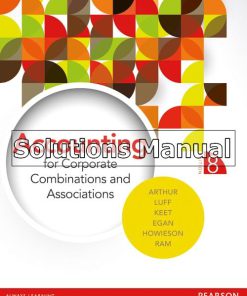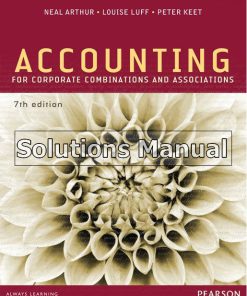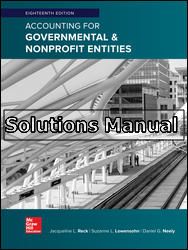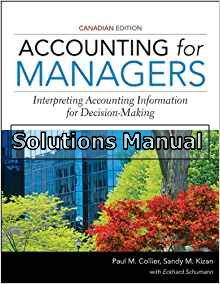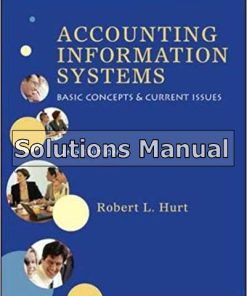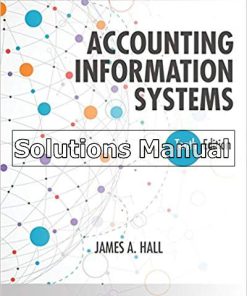$26.50$50.00 (-47%)
In stock
Macroeconomics Canadian 2nd Edition Hubbard Solutions Manual.
Categories: Canadian, Economics, Solutions Manual
Tags: 2nd Edition, Canadian, Childs, Hubbard, Macroeconomics, OBrien, Serletis, Solutions Manual
You may also like
Macroeconomics Canadian 2nd Edition Hubbard Solutions Manual

Product details:
- ISBN-10 : 013443126X
- ISBN-13 : 978-0134431260
- Author: Glenn Hubbard, Tony O’Brien
By building from the specific example to the general case this text fosters student engagement. It delivers complete economics coverage using many fresh, lively, real-world examples from newspapers, magazines, Web sites, and professional journals from around the world.
Table contents:
- Part 1 Introduction
- Chapter 1 Economics: Foundations and Models
- Introduction: Economics: Foundations and Models
- 1.1 Three Key Economic Ideas
- 1.2 The Economic Problems All Societies Must Solve
- The Modern Mixed Economy
- 1.3 Economic Models
- Positive and Normative Analysis
- 1.4 Microeconomics and Macroeconomics
- 1.5 The Language of Economics
- Economics in Your Life and Career
- Chapter Key Terms
- Chapter Summary and Problems
- Summary and Problems 1.2
- Summary and Problems 1.3
- Summary and Problems 1.4
- Summary and Problems 1.5
- Critical Thinking Exercises
- Appendix: Using Graphs and Formulas
- Slopes of Lines
- Determining Cause and Effect
- Formulas
- Problems and Applications
- Chapter 2 Trade-offs, Comparative Advantage, and the Market System
- Introduction: Trade-offs, Comparative Advantage, and the Market System
- 2.1 Production Possibilities Frontiers and Opportunity Costs
- Apply the Concept: Facing the Trade-offs of Health Care Spending
- 2.2 Comparative Advantage and Trade
- Absolute Advantage versus Comparative Advantage
- 2.3 The Market System
- The Gains from Free Markets
- Economics in Your Life and Career
- Chapter Key Terms
- Chapter Summary and Problems
- Summary and Problems 2.2
- Summary and Problems 2.3
- Critical Thinking Exercises
- Chapter 3 Where Prices Come From: The Interaction of Supply and Demand
- Introduction: Where Prices Come From: The Interaction of Supply and Demand
- 3.1 The Demand Side of the Market
- Variables that Shift Market Demand
- Apply the Concept: Millennials Shake Up the Markets for Soda, Groceries, Big Macs, and Running Shoes
- 3.2 The Supply Side of the Market
- Variables That Shift Market Supply
- A Change in Supply versus a Change in Quantity Supplied
- 3.3 Market Equilibrium: Putting Buyers and Sellers Together
- Demand and Supply Both Count
- 3.4 The Effect of Demand and Supply Shifts on Equilibrium
- The Effect of Shifts in Demand and Supply over Time
- Don’t Let This Happen to You
- Economics in Your Life and Career
- Chapter Key Terms
- Chapter Summary and Problems
- Summary and Problems 3.2
- Summary and Problems 3.3
- Summary and Problems 3.4
- Critical Thinking Exercises
- Appendix: Quantitative Demand and Supply Analysis
- Problems and Applications
- An Inside Look: Tim Hortons Launches Kids’ Menu in Push to Return to Its Roots
- Part 2 Macroeconomic Foundations and Long-Run Growth
- Chapter 4 GDP: Measuring Total Production and Income
- Introduction: Measuring Total Production and Income
- 4.1 Gross Domestic Product Measures Total Production
- Production, Income, and the Circular-Flow Diagram
- Measuring GDP
- Statistical Discrepancy
- Measuring GDP Using the Value-Added Method
- 4.2 Does GDP Measure What We Want It to Measure?
- Apply the Concept: GDP and Happiness
- 4.3 Real GDP versus Nominal GDP
- Comparing Real GDP and Nominal GDP
- 4.4 Other Measures of Total Production and Total Income
- Economics in Your Life and Career
- Chapter Key Terms
- Chapter Summary and Problems
- Summary and Problems 4.2
- Summary and Problems 4.3
- Summary and Problems 4.4
- Critical Thinking Exercises
- Chapter 5 Unemployment and Inflation
- Introduction: Unemployment and Inflation
- 5.1 Measuring the Unemployment Rate and the Labour Force Participation Rate
- Problems with Measuring the Unemployment Rate
- 5.2 Types of Unemployment
- 5.3 Explaining Unemployment
- Efficiency Wages
- 5.4 Measuring Inflation
- Is the CPI Accurate?
- 5.5 Using Price Indexes to Adjust for the Effects of Inflation
- 5.6 Real versus Nominal Interest Rates
- 5.7 Does Inflation Impose Costs on the Economy?
- Economics in Your Life and Career
- Chapter Key Terms
- Chapter Summary and Problems
- Summary and Problems 5.2
- Summary and Problems 5.3
- Summary and Problems 5.4
- Summary and Problems 5.5
- Summary and Problems 5.6
- Summary and Problems 5.7
- Critical Thinking Exercises
- Chapter 6 Economic Growth, the Financial System, and Business Cycles
- Introduction: Economic Growth, the Financial System, and Business Cycles
- 6.1 Long-Run Economic Growth
- Calculating Growth Rates and the Rule of 70
- Apply the Concept: Can India Sustain Its Rapid Growth?
- 6.2 Saving, Investment, and the Financial System
- The Macroeconomics of Saving and Investment
- Solved Problem 6.1
- 6.3 The Business Cycle
- Don’t Let This Happen to You
- Economics in Your Life and Career
- Chapter Key Terms
- Chapter Summary and Problems
- Summary and Problems 6.2
- Summary and Problems 6.3
- Critical Thinking Exercises
- Chapter 7 Long-Run Economic Growth: Sources and Policies
- Introduction: Long-Run Economic Growth: Sources and Policies
- 7.1 Economic Growth over Time and around the World
- Small Differences in Growth Rates Are Important
- “The Rich Get Richer and…”
- 7.2 What Determines How Fast Economies Grow?
- Which Is More Important for Economic Growth: More Capital or Technological Change?
- Solved Problem 7.1
- 7.3 Economic Growth in Canada
- Is Canada Headed for a Long Period of Slow Growth?
- 7.4 Why Isn’t the Whole World Rich?
- Solved Problem 7.2
- Why Don’t More Low-Income Countries Experience Rapid Growth?
- The Benefits of Globalization
- 7.5 Growth Policies
- Improving Health and Education
- Is Economic Growth Good or Bad?
- Economics in Your Life and Career
- Chapter Key Terms
- Chapter Summary and Problems
- Summary and Problems 7.2
- Summary and Problems 7.3
- Summary and Problems 7.4
- Summary and Problems 7.5
- Critical Thinking Exercises
- An Inside Look: The Worries about China’s Slowing Growth
- Part 3 Short-Run Fluctuations
- Chapter 8 Aggregate Expenditure and Output in the Short Run
- Introduction: Aggregate Expenditure and Output in the Short Run
- 8.1 The Aggregate Expenditure Model
- Macroeconomic Equilibrium
- 8.2 Determining the Level of Aggregate Expenditure in the Economy
- Apply the Concept: Do Changes in Consumer Confidence Affect Consumption Spending?
- The Relationship between Consumption and National Income
- Solved Problem 8.1
- Planned Investment
- Government Purchases
- 8.3 Graphing Macroeconomic Equilibrium
- Showing a Recession on the 45°-Line Diagram
- 8.4 The Multiplier Effect
- A Formula for the Multiplier
- Solved Problem 8.2
- 8.5 The Aggregate Demand Curve
- Economics in Your Life and Career
- Chapter Key Terms
- Chapter Summary and Problems
- Summary and Problems 8.2
- Summary and Problems 8.3
- Summary and Problems 8.4
- Summary and Problems 8.5
- Critical Thinking Exercises
- Appendix: The Algebra of Macroeconomic Equilibrium
- Review Questions
- Chapter 9 Aggregate Demand and Aggregate Supply Analysis
- Introduction: Aggregate Demand and Aggregate Supply Analysis
- 9.1 Aggregate Demand
- Shifts of the Aggregate Demand Curve versus Movements along It
- Apply the Concept: Canada’s Mini Recession
- Solved Problem 9.1
- 9.2 Aggregate Supply
- Shifts of the Short-Run Aggregate Supply Curve versus Movements along It
- 9.3 Macroeconomic Equilibrium in the Long Run and the Short Run
- Expansion The Short-Run Effect of an Increase in Aggregate Demand
- 9.4 A Dynamic Aggregate Demand and Aggregate Supply Model
- What Is the Usual Cause of Inflation?
- Economics in Your Life and Career
- Chapter Key Terms
- Chapter Summary and Problems
- Summary and Problems 9.2
- Summary and Problems 9.3
- Summary and Problems 9.4
- Critical Thinking Exercises
- Appendix: Macroeconomic Schools of Thought
- The New Classical Model
- The Real Business Cycle Model
- An Inside Look: CIBC downgrades its 2016 Canadian economic outlook for the second time in a month
- Part 4 Monetary and Fiscal Policy
- Chapter 10 Money, Banks, and the Bank of Canada
- Introduction: Money, Banks, and the Bank of Canada
- 10.1 What Is Money, and Why Do We Need It?
- What Can Serve as Money?
- 10.2 How Is Money Measured in Canada Today?
- Apply the Concept: Are Bitcoins Money?
- 10.3 How Do Banks Create Money?
- Using T-Accounts to Show How a Bank Can Create Money
- The Simple Deposit Multiplier
- Solved Problem 10.2
- 10.4 The Bank of Canada
- The Bank of Canada’s Operating Band for the Overnight Interest Rate
- The Bank of Canada’s Approach to Monetary Policy
- 10.5 The Quantity Theory of Money
- How Accurate Are Estimates of Inflation Based on the Quantity Theory?
- Economics in Your Life and Career
- Chapter Key Terms
- Chapter Summary and Problems
- Summary and Problems 10.2
- Summary and Problems 10.3
- Summary and Problems 10.4
- Summary and Problems 10.5
- Critical Thinking Exercises
- Chapter 11 Monetary Policy
- Introduction: Trade-offs, Comparative Advantage, and the Market System
- 11.1 What Is Monetary Policy?
- 11.2 The Money Market and the Bank of Canada’s Choice of Monetary Policy Targets
- How the Bank of Canada Manages the Money Supply: A Quick Review
- Choosing a Monetary Policy Target
- 11.3 Monetary Policy and Economic Activity
- The Effects of Monetary Policy on Real GDP and the Price Level
- Can the Bank of Canada Eliminate Recessions?
- 11.4 Monetary Policy in the Dynamic Aggregate Demand and Aggregate Supply Model
- Using Monetary Policy to Fight Inflation
- 11.5 A Closer Look at the Bank of Canada’s Setting of Monetary Policy Targets
- The Taylor Rule
- 11.6 Central Bank Policies during the 2007–2009 Global Financial Crisis
- The Changing Mortgage Market in the United States
- Economics in Your Life and Career
- Chapter Key Terms
- Chapter Summary and Problems
- Summary and Problems 11.2
- Summary and Problems 11.3
- Summary and Problems 11.4
- Summary and Problems 11.5
- Summary and Problems 11.6
- Critical Thinking Exercises
- Chapter 12 Fiscal Policy
- Introduction: Fiscal Policy
- 12.1 What Is Fiscal Policy?
- Where Does the Money Go?
- Apply the Concept The Exploding Costs of Health Care
- 12.2 The Effects of Fiscal Policy on Real GDP and the Price Level
- 12.3 Fiscal Policy in the Dynamic Aggregate Demand and Aggregate Supply Model
- 12.4 Government Purchases and Tax Multipliers
- The Effect of Changes in Tax Rates
- Solved Problem 12.1
- 12.5 The Limits of Fiscal Policy as a Stimulus
- Crowding Out in the Long Run
- 12.6 Deficits, Surpluses, and Federal Government Debt
- Solved Problem 12.2
- 12.7 The Effects of Fiscal Policy in the Long Run
- The Economic Effect of Tax Reform
- Economics in Your Life and Career
- Chapter Key Terms
- Chapter Summary and Problems
- Summary and Problems 12.2
- Summary and Problems 12.3
- Summary and Problems 12.4
- Summary and Problems 12.5
- Summary and Problems 12.6
- Summary and Problems 12.7
- Critical Thinking Exercises
- Appendix: A Closer Look at the Multiplier Formula
- A Formula for the Government Purchases Multiplier
- The “Balanced Budget” Multiplier
- The Multiplier in an Open Economy
- Problems and Applications
- Chapter 13 Inflation, Unemployment, and Bank of Canada Policy
- Introduction: Inflation, Unemployment, and Bank of Canada Policy
- 13.1 The Discovery of the Short-Run Trade-off between Unemployment and Inflation
- Is the Short-Run Phillips Curve Stable?
- 13.2 The Short-Run and Long-Run Phillips Curves
- How Does a Vertical Long-Run Phillips Curve Affect Monetary Policy?
- Solved Problem 13.1
- 13.3 Expectations of the Inflation Rate and Monetary Policy
- Is the Short-Run Phillips Curve Really Vertical?
- 13.4 Bank of Canada Policy from the 1970s to the Present
- Inflation Targeting, 1989–Present
- The 2007–2009 Global Recession and the Crisis in Monetary Policy
- Economics in Your Life and Career
- Chapter Key Terms
- Chapter Summary and Problems
- Summary and Problems 13.2
- Summary and Problems 13.3
- Summary and Problems 13.4
- Critical Thinking Exercises
- Part 5 The International Economy
- Chapter 14 Macroeconomics in an Open Economy
- Introduction: Macroeconomics in an Open Economy
- 14.1 The Balance of Payments: Linking Canada to the International Economy
- The Financial Account
- Solved Problem 14.1
- 14.2 The Foreign Exchange Market and Exchange Rates
- How Do Shifts in Demand and Supply Affect the Exchange Rate?
- Some Exchange Rates Are Not Determined by the Market
- 14.3 The International Sector and National Saving and Investment
- Solved Problem 14.3
- 14.4 The Effect of a Government Budget Deficit on Investment
- 14.5 Monetary Policy and Fiscal Policy in an Open Economy
- Economics in Your Life and Career
- Chapter Key Terms
- Chapter Summary and Problems
- Summary and Problems 14.2
- Summary and Problems 14.3
- Summary and Problems 14.4
- Summary and Problems 14.5
- Critical Thinking Exercises
- An Inside Look: U.S. short sellers betting on Canadian housing crash: ‘An accident waiting to happen’
- Chapter 15 The International Financial System
- Introduction: The International Financial System
- 15.1 Exchange Rate Systems
- 15.2 The Current Exchange Rate System
- Apply the Concept: The Big Mac Theory of Exchange Rates
- The Euro
- Pegging against the US Dollar
- 15.3 International Capital Markets
- Economics in Your Life and Career
- Chapter Key Terms
- Chapter Summary and Problems
- Summary and Problems 15.2
- Summary and Problems 15.3
- Critical Thinking Exercises
- An Inside Look: Four ways the Fed’s rate hike will affect our lives up north
- Glossary
People also search:
macroeconomics 2nd edition
macroeconomics 2nd edition pdf
macroeconomics canadian edition
macroeconomics canadian edition pdf
cengage macroeconomics answers chapter 2







